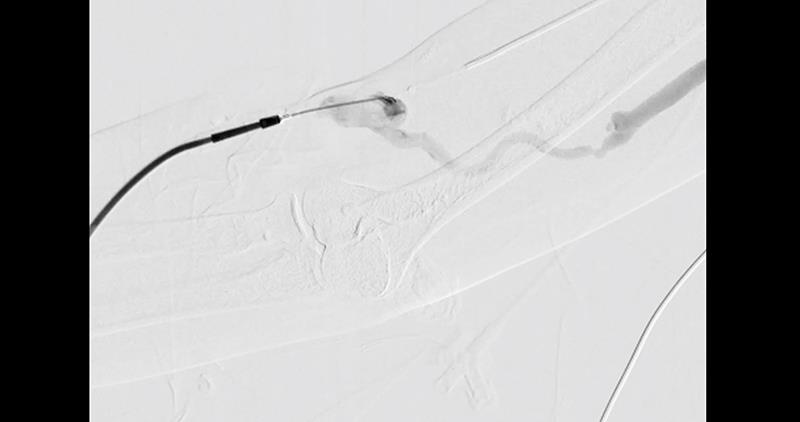Sirolimus-eluting PTA balloons keep most complex infrainguinal lesions CD-TLR–free for a year





The use of a sirolimus-eluting balloon (SEB) maintains freedom from clinically driven target lesion revascularization (CD-TLR) at 1 year in nearly 3 out of 4 long, complex infrainguinal lesions, as shown in the PRISTINE registry of patients in Singapore with chronic limb-threatening ischaemia.
CD-TLR was defined as any re-intervention performed for ≥50 percent stenosis at the target lesion following documented recurrent or continuing clinical symptoms.
The 12-month freedom from CD-TLR, a secondary outcome measure, was 74.3 percent, while the corresponding 6-month rate, the primary performance outcome measure, was 83.7 percent. [Cardiovasc Intervent Radiol 2024;47:863-874]
Both rates were deemed "satisfactory" given the frail cohort with multiple comorbidities, wrote lead author Dr Tjun Yip Tang, a senior vascular and general surgeon at the Vascular & Endovascular Clinic, Gleneagles Medical Centre, Singapore.
No device-related deaths or serious adverse events were reported within 30 days following the percutaneous transluminal angioplasty (PTA) procedure.
Of note, the technical success rate was 100 percent, indicating that the SEB used was able to cross and dilate all the lesions, and achieve a residual angiographic stenosis ≤30 percent.
Extend use beyond tibial arteries
PRISTINE was designed in light of the pilot PRESTIGE study, which investigated the same SEB for 33 de novo and re-stenotic lesions in the tibial arteries of 25 patients. Both were prospective, nonrandomized, single-arm studies conducted at the Singapore General Hospital. [J Endovasc Ther 2021;28:555-566]
The SEB used in both studies features spherical micro-reservoirs made from a solid solution of biodegradable polymer intermixed with sirolimus, coated onto a standard PTA balloon catheter. This design enables the controlled and sustained release of sirolimus in an "eluting" manner upon drug transfer to the arterial wall. [J Endovasc Ther 2020;27:683-690; JACC Cardiovasc Interv 2024;17:1547-1556]
PRISTINE aimed to extend the use of the SEB by including lesions in the femoropopliteal (FP) segments and other nontibial below-knee arteries that were not addressed in PRESTIGE.
A total of 112 infrainguinal lesions in 75 patients (mean age 69 years, 66.7 percent male, 72 percent Chinese) were treated with PTA using the SEB. All but seven patients had diabetes (90.7 percent), and over two-thirds had end-stage renal disease (37.3 percent).
Target lesion length >5 cm (mean 22.4 cm) and classification as Trans-Atlantic Inter-Society Consensus II C or D were angiographic inclusion criteria.
As expected, most lesions were located in the tibial arteries (43.8 percent), while 38.4 percent of lesions were in the FP segments. Re-stenotic lesions accounted for 32.1 percent of the total. Moderate or severe vessel wall calcification was present in 88.4 percent of the lesions.
A competing risk analysis indicated that no specific lesion location (FP, below-the-knee, or inframalleolar) favoured freedom from CD-TLR (p=0.316).
Target lesion primary patency (TLPP) rate was 74.4 percent at 6 months and 58.1 percent at 12 months. Similarly, no specific lesion location favoured TLPP (p=0.859).
Other outcome endpoints included amputation-free survival rates of 83.6 percent and 72.6 percent at 6 and 12 months, respectively.
Complete wound healing was achieved in 56.4 percent of patients at 6 months and in 79.2 percent at the 12-month follow-up. This may partly explain the significant improvement in quality of life from baseline, as measured by the EuroQol 5-dimension visual analogue scale (p≤0.05).
“The results are encouraging in that they can reproduce similar results to PRESTIGE albeit with a bigger sample cohort with multiple proceduralists involved,” concluded Tang.